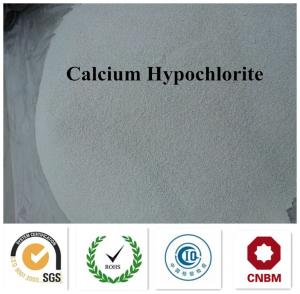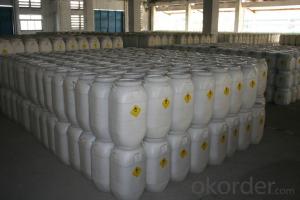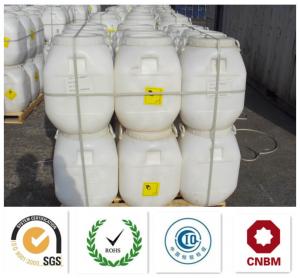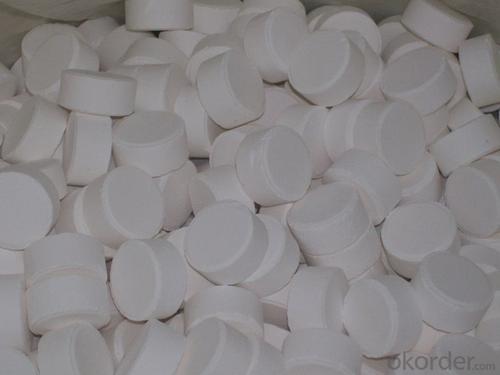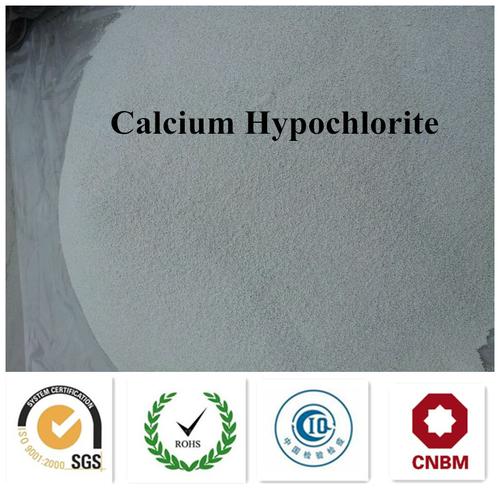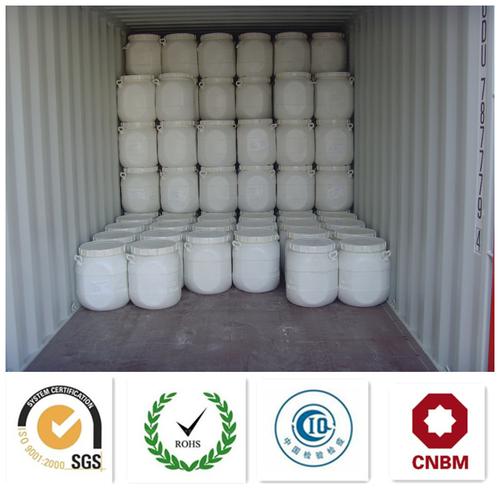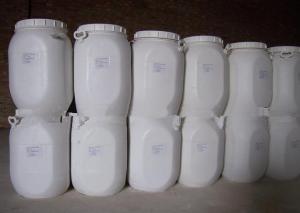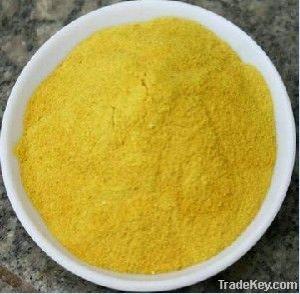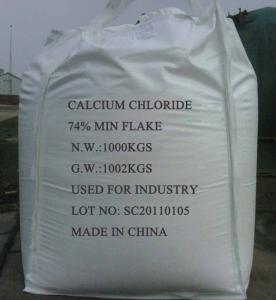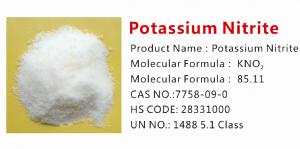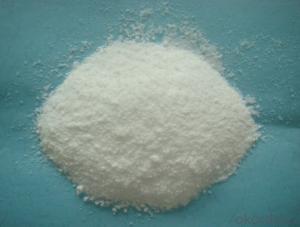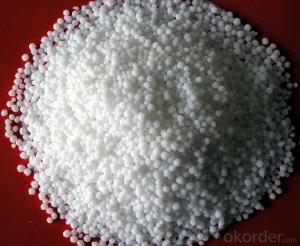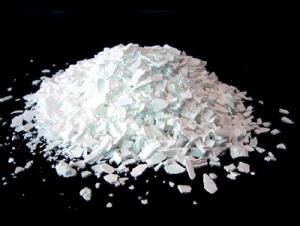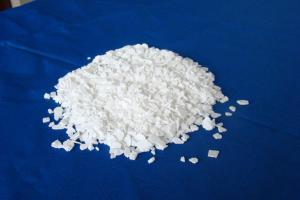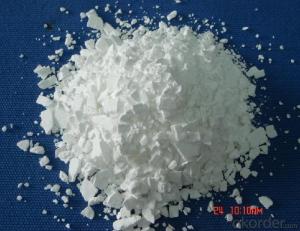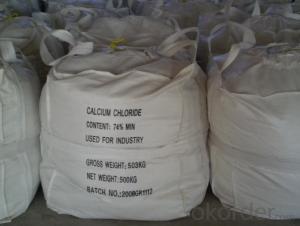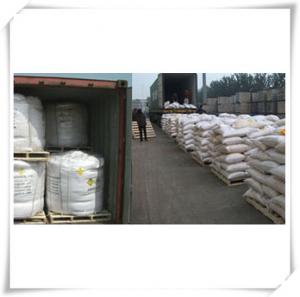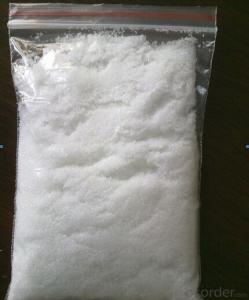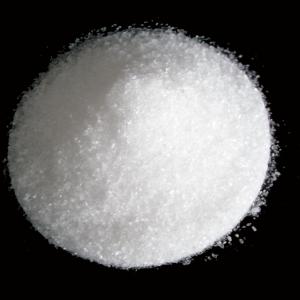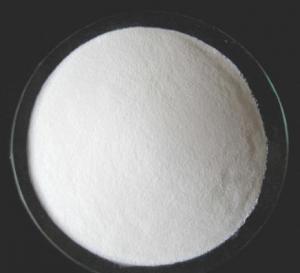Calcium Hypochlorite Golden-Chlor Best Quality
- Loading Port:
- Tianjin
- Payment Terms:
- TT OR LC
- Min Order Qty:
- 20 m.t.
- Supply Capability:
- 2000 m.t./month
OKorder Service Pledge
OKorder Financial Service
You Might Also Like
Calcium Hypochlorite
Introduction:
CNBM GROUP is the biggest water Treatment Factory in China. Our Product include: Calcium Hypochlorite, TCCA, SDIC, PAC, Sodium Sulphite, Sodium Thiosulfate etc.
CNBM One year can produce 18,000MT Calcium Hypochlorite with two model, one is 65% and one is 70%. More important we have 3 advantages, Firstly: High effective chlorine content Secondly: Good stability. Can be stored a long time at normal temperature with little chlorine loss; Third:Good solubility, less water-insoluble matters.
Technical Specifications:
Calcium Hypochlorite 65%
Index Name | Top Grade | First Grade |
Chlorine Content ≥ | 65% | 60% |
Moisture ≤ | 3% | 3% |
Yearly Loss of Active Chlorine | 8% | 8% |
Calcium Chloride | 9% | 10% |
Color | White or Light-grey | ----- |
Shape | Power & Granular |
Calcium Hypochlorite 70%
Index Name | Top Grade | First Grade | Quality Product |
Chlorine Content ≥ | 70% | 67% | 65% |
Granularity(14-50 mesh)% ≥ | 90 | 87 | 87 |
Moisture % | 5.5~10 |
Tablets Forms
Weight | 200 gram | 150gram | 100gram | 50gram | 30gram | 20gram | 15gram | 10gram |
Diameter(mm) | 76 | 70 | 50 | 42 | 30 | 30 | 30 | 30 |
Height(mm) | 25 | 21 | 26 | 27 | 22 | 16 | 12 | 8 |
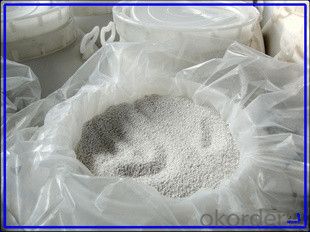
Applications:
1. For bleaching purpose of wood pulp, silk, cloth and fibre.
2. Disinfection and water-treatment.
3. Disinfectant for chemical poisonous and radioactive substance.
Formula Experiment Design: (Base on 1MT Water)
Constitue Dosage
Calcium Hypochlorite 65% 100kg
Disinfection Liquid 1% Calcium Hypochlorite 65% 1.7g
Shipping Containers:
45—50kg Plastic or Steel Drums with Inner Plastic Bag.
Cautions
1. Should be stored in cool and dry warehouse away from heating sources and avoid direct sunlight.
2. In transportation, contact with such should be avoided as sunlight, heating,moisture, organics, oil and acids.
Other Information please check the MSDS.
Appearance: white to light grey granules/tablet/powder
Effective chlorine: 65% (Calcium porcess); 70% (Sodium process).
Application: 1) water treatment
2) disinfection of pool
3) bleaching of fabric,cotton etc.
| Appearance: | white or light grey powder/granule/tablet |
| Effective Chlorine: | 65% - 70% |
| Chlorine loss: | 7% max |
| UN No.: | 2880 |
| Other name: | bleaching powder |
- Q: How does inorganic salts maintain osmotic pressure and pH
- PH ~ inorganic salts of carbonates bicarbonate, hydrogen phosphate / dihydrogen phosphate, can help regulate the pH value of the internal environment, even if the external environment Zoumu changes, the environment will not change too fast, there will be a Buffer room
- Q: I'm said that with the increase of temperature the inorganic salts will decrease. Will that be correct?
- Usually solubility will increase with increasing temperature but there are a significant number of exceptions which show the opposite.
- Q: Please help i need the answer for a classwork assignment due today. I've looked everywhere online but i cant find the answer.
- the web page (below) discusses: Basal Salt Mixtures The use of balanced salt solution (BSS) in cell and tissue culture is generally attributed to early workers in the field. In 1885, Sydney Ringer developed a solution of inorganic salts designed to maintain contractility of mammalian heart tissue. A less specific salt solution was designed by Tyrode for use in work with primary mammalian cells. Tyrode's salt solution became the accepted fluid for diluting protein components of media of natural origin. Since that time, many other balanced salt solutions have been developed for use in cell and tissue culture. The current role of balanced salt solution in cell culture is multi-faceted and can be divided into four principle functions. see web page for extensive discussion on the good things about it
- Q: Can inorganic salts act as stabilizers for emulsified asphalt?
- Heze Tongren Road Machinery Co., Ltd. is a asphalt heating and storage equipment as the main body, set road maintenance equipment production, asphalt library design and transformation of technical services, to undertake asphalt library / depot and other construction and installation, industrial pipelines and chemical equipment The installation of the installation of the boiler, the installation of steel structures and accessories sales, such as integrated services in one company.
- Q: What cells produce the collagen and inorganic salts of bone matrix?
- Inorganic Salts In Bone
- Q: Is bromine an inorganic salt?
- Bromide is an anion which joins with a cation to make a salt like Sodium Chloride (table salt) Bromine is a liquid bleach, similar to chlorine gas. oganic compounds are those which have carbon or sulphur base
- Q: Does the plant absorb some of the inorganic salt?
- Plants absorb moisture and absorb inorganic salts are two relatively independent processes.
- Q: Is the inorganic salt related to the excitement
- Nerve conduction is the action potential along the order of nerve fibers occur. Nerve fibers are stimulated at some point if the intensity of this stimulus is sufficient, the response of this point to the stimulus is the change of polarity: Na + inflow, K + outflow, the original positive film surface, and now becomes negative. This makes it and its left and right adjacent (positive) have a potential difference between. So that the left and right adjacent films also undergo a change in permeability, and the action potentials are also generated in the same manner as in the above process. So step by step chain reaction and the emergence of the action potential of the order of transmission, which is the nerve impulse conduction.
- Q: I had asked a similar question on GC operation last week, but for different kinds of compounds.For my biochem research project at school, I'm testing the ability of a species of bacteria to biodegrade alcohols found in gasoline (methanol, ethanol, isopropyl, tert-butyl and cyclohexanol). The bacteria is growing in a solution of minute amounts of alcohols and Mineral Medium, which is basically just water and dissolved inorganic salts (CaCl2, KH2PO4, NH4NO3 and MgSO4).I know GC's are primarily used to separate organic mixtures. Can a GC separate organic compounds dissolved in salt water? Is it safe to put salt water in a GC? Or would I have to do an extraction to separate the alcohols and run the organic extract through the GC?
- Do not let salts enter the GC. You will have to perform an extraction step and run that. Salts can precipitate in the column or degrade into reactive species that can corrode the GC. Water is OK since it will not destroy the column (I've run aqueous solutions before), but salts are not.
- Q: Is urea an inorganic salt?
- Is not organic matter ah inorganic salts are present in the body and food minerals in the mineral, composed of organic matter and inorganic synthesis of the human body has been found to have more than 20 kinds of essential inorganic salts, about 4 to 5% of body weight. More (> 5g) for calcium, phosphorus, potassium, sodium, chlorine, magnesium, sulfur seven; daily dietary requirements are more than 100mg, known as constant elements. Other low content, with the modern analysis of technological progress Iron, copper, zinc, manganese, cobalt, molybdenum, selenium, chromium, nickel, silicon, fluorine, vanadium and other elements were found by atomic absorption spectroscopy, neutron activation, plasma emission spectroscopy and other trace analysis methods. But also the human body is necessary, the daily dietary requirements for the amount of μg ~ mg called trace elements.
Send your message to us
Calcium Hypochlorite Golden-Chlor Best Quality
- Loading Port:
- Tianjin
- Payment Terms:
- TT OR LC
- Min Order Qty:
- 20 m.t.
- Supply Capability:
- 2000 m.t./month
OKorder Service Pledge
OKorder Financial Service
Similar products
Hot products
Hot Searches
Related keywords

